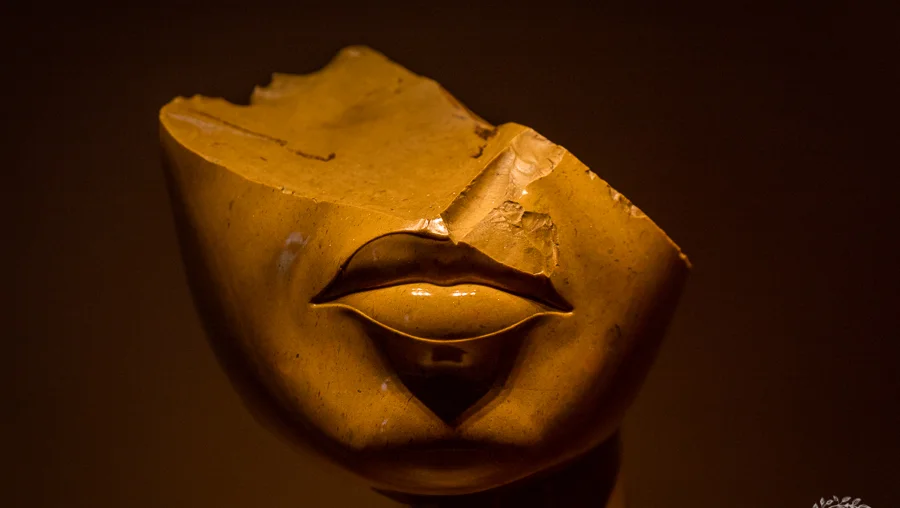The indomitable spirit cannot be diminished — by negligence, by war, by time spun farther than the grasp of memory. This occurs to me on September ninth, 2001, in the Egyptian gallery of New York’s Metropolitan Museum of Art, as I stand before the only remaining fragment of an ancient sculpture. The body has vanished, and most of the head is gone. What remains is a small artefact, about six inches high: an elegant mouth — smiling, in repose — and the beginning curve of a face, carved from yellow jasper. Between ragged fractures where the stone is sheared off — one just above the top lip, the other below the chin — the mouth has been sculpted with astonishing precision by the craft of a culture now strewn across the debris field of history. This statue, all that’s left of the queen of a remote age, was fashioned in devotion and shattered by war, almost twenty-five centuries ago. And still, she smiles.
I remain in the gallery for a long while, absorbing the details of this remarkable object: bright and smooth, polished to a high sheen. Yellow jasper, symbol of the imperishable, the rain-bringer, a stone reputed to drive away evil spirits, has long been associated with healing. Perhaps this mouth, so fragile, the instrument of a forgotten voice, has been preserved by virtue of the jasper’s protection. This relic endures, even as the Taliban destroy stone Buddhas in Afghanistan. In countless guises, the instinct for beauty prevails.
Two days later, back home in British Columbia, as I prepare to work a stone I found on the mountain north of where I live, terrorists fly hijacked airplanes into the World Trade Center, into the Pentagon, into the ground. Like their ancient allies, they tear down the standing stones, endeavor to destroy all that is foreign and strange. The old fires have not stopped burning.
I am drawn away from the shop and into my grief for many days. I sit with my wife in the quiet sanctuary she has made of our yard. The first ochre leaves appear, and we wonder how to make sense of such unfathomable events. My eight-year-old daughter writes a poem about the end of summer, in which birds fly to nice, warm places. Safe passage. As the season turns, I pray that I find the wisdom to weigh, in my own small and quotidian life, the will to heal against the wish to harm.
When I can no longer abide images from the television, when the rawness within me must be assuaged, I return to my workbench. My affliction is softened as I cradle my tools and guide them across the stone, restoring a shattered visage. The dust gathers into great storm clouds as I work, falls like ash onto every surface of my shop. The facade of the stone cracks, gathers itself into the contours of a resolute chin, a strong mouth and a cheek rising toward a restful eye.
Rage and tears and a strange dread, lurking and tenebrous, find their way into the rhythm of my work. Bits of loose stone fall onto the floor, abrade my skin with their sharp edges, scrape the benchtop I so carefully protect from harm. I persist, straining to reclaim, in the grain of dark stone, the soft faces of those now lost to our sight. I mourn the death, too, of the isolated innocence of my culture. And I try to answer the questions of my four-year-old son, who cannot understand why the hijackers would hurt anyone. He devises surprisingly elaborate plans for talking to them, for asking them to stop.
He watches me work, brings me tools, draws close in this time of elemental fear. My hands, searching for the stone’s redemption, trace their way across the emerging contours of a jaw, and the rough edge where the forehead will be. I imagine the craftsmen of the jasper queen, and I wonder, as I inspect my work during a bright and warm afternoon, if it’s her voice I hear, humming among the trees out back. I discover, once again, that the simple work of hands is a guide in my own healing. I am shaped by the work of creativity as a stone is by tools. And I am sustained, finally, by the hope that my one stone might stand with the destroyed and colossal Buddhas, with the scattered and the fallen, with those on their way back home.
Creativity can be a deep sustenance — whether in stone or wood or soil. And though my carving is crude, fails utterly to match the surpassing skill of those ancient craftsmen, I persevere; for the work of creation calls not only to the practiced hand. Slowly, easing into the surface, I peel back the many layers that hide the finished face. The air is thick with transformations.
I wash dust from the stone. The bright surface beneath, smoothed by countless tool strokes, appears alive. Dark striations weave their way across the rudimentary cheek, and flecks of white — feldspar — scatter like snowflakes along the brow. There’s more work, much more: the nose, the eyes, the left side of the jaw. But I’ve begun. And as I gaze upon the face before me, collected from the ashes of mountains and the visions of my own troubled days, I glimpse a woman both serene and fair. She looks upon our fractured world with an indomitable spirit. And she smiles.
